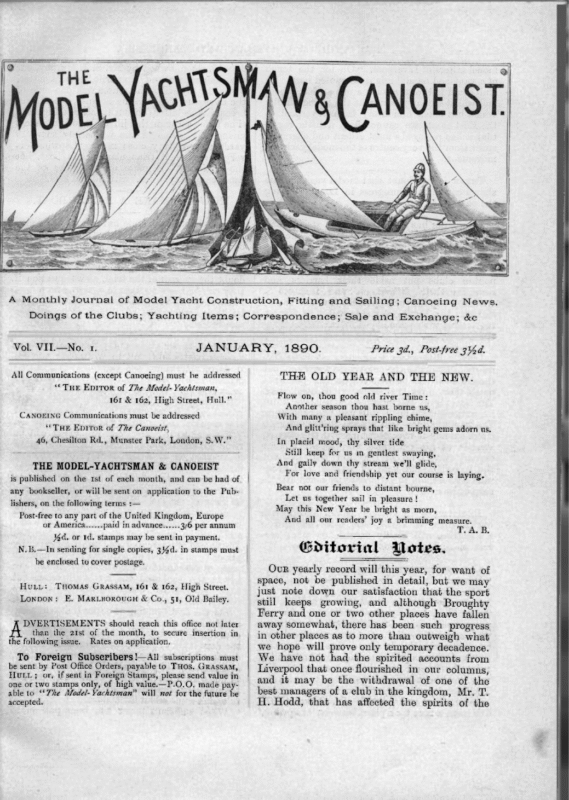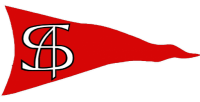A Monthly Journal of Model Yacht Construction, Fitting and Sailing; Canoeing News, Doings of the Clubs; Yachting Items; Correspondence; Sale and Exchange; &c Vol. VII.—No., 1. JANUARY, All Communications (except Canoeing) must he addressed 1890. THE OLD YEAR AND THE : ; ‘THE Epiror of The Model- Yachtsman, 161 & 162, High Street, Hull.” | Flow Price 32., Post-free z¥ed. on, thou good old NEW. river Time: Aaother season thou hast borne us, CANOEING Communications must be addressed With many a pleasant rippling chime, “THE Epitor of The Canoeist, And glitt’ring sprays that 46, Chesilton Rd,, Munster Park, London, 5. W.” like bright gems adorn us. In placid mood, thy silver tide still keep for us in gentlest swaying, THE MODEL-YACHTSMAN & CANOEIST And For is published on the 1st of each month, and can be had of | any bookseller, or will be sent on application to the Pub- thy stream we’ll glide, ing, on: Let us together sail in pleasure ! May this New Year be bright as morn, Post-free to any part of the United Kingdom, Europe And all our readers’ joy a brimming measure. or America…… paid in advance…… 3/6 per annum T.A.B Jed. or Id. stamps may be sent in payment. “a N.L,—In sending for single copies, 344d. in stamps must pe down | Bear not our friends to distant bourne, lishers, on the following terms :— be enclosed to cover postage. gaily t se is nebicaiar1 friendshi pista st tole levee Ads Gditorial Totes, Our yearly record will this year, for want of space, not be published in detail, but we may Hvuit: THomMas GRassam, 161 & 162, High Street. just note down our satisfaction that the sport — Ferry and one or two other places have fallen Lonpon: E. MARLBorouGu & Co., 51, Old Bailey. DVERTISEMENTS should reach this office not later still keeps growing, and = away somewhat, there has although been such Broughty progress than the 21st of the month, to secure insertion in | in other places as to more than outweigh what To Foreign Subseribers!—All subscriptions must | We have not had the spirited accounts from the following issue. Rates on application. we hope will prove only temporary decadence. be sent by Post Office Orders, payable to THos. GrassaM, | T,iverpool that once flourished in our columns, HULL; or, if sent in Foreign Stamps, please send value in one or two stamps only, of high value.—P.O.O. made pay- able to “Fhe Model-¥achtsman” will not for the future be accepted. : : and it may be the withdrawal of one of the best managers of a club in the kingdom, Mr. T. H. Hodd, that has affected the spirits of the
THE MODEL-YACHTSMAN model sailers of Liverpool, ‘Oh for the touch of a vanished hand;” might be quoted here. No club could fail to miss such a one as Mr. Hodd, and whilst feeling pleasure at the rising in life which has taken him away from Liverpool to the Hast coast, we cannot help a little regret that it has removed a most ardent and energetic spirit from the very centre of the model yachting movement. —Q— THERE is no doubt that model yachting has shown considerable progress in London during the past year. AND CANOEIST 47 x 15, sloop, owned by Mr. 8. J. Murphy, our vice-comrnodore, and ‘ Spindrift,’ 40 x 12, cutter, owned by myself. The course was one mile of the river with tide, beating against. a northerly breeze. The latter (Spendrift) after losing some tine twice through the jib tack and fore sheet giving way, came in the winner by some 10 yards after a very close race. ‘Lapwing’ is very like a solent triangular section boat, but the ‘Spindrift’ is more on the lines of the American ‘ Mayflower,’ with a fixed keel.” — HOW TO MAKH O— A PAPER BOAT. ——O— YORKSHIRE has also made great strides, and several places on the South coast are coming to the front in a satisfactory manner. WE hope the coming year will see the Metro- politan clubs put aside their barriers and reconcile their differences, and institute a challenge cup for their splendid group of clubs; and that the South coast men will also furnish themselves with some object calculated to bring them together, —_(O— Lirrie differences may arise at inter-club meets to minimise the enjoyment for some, but these should not be dwelt upon nor pondered until they grow too bitter to be swallowed. The benefits of the intercourse between clubs far outweighs the little rubs and bits of friction. The fibre of a man will always withstand such small chafing as may occur, even if the serving strands of his politeness may be for a time carried away. So let the New Year blot out the record of old year difficulties, and every man bear a hand to get aboard as much friendship as he can. -—O— ReGIster.—We publish in full this month our Register of Clubs, and shall be glad if Secretaries will kindly furnish us with corrections and alterations for the New Year. ——Yj-—- ONE For JANUARY.—A correspondent writes— ‘‘Newtown School, Waterford, December 11th, 1889.—Dear sir, I have great pleasure in informing you that a meeting was held in the Town Hall, here, yesterday evening, for the purpose of forming a model yacht club. Officers were appointed and a set of general rules drawn up and accepted. It is still left to the committee to draw up the measurement and sailing rules; but we are very glad to have ‘got under way, and hope for some good sport next year. I will send you a copy of our rules when they are completed and printed. On Saturday, the 7th inst., a race took place between ‘ Lapwing,’ Several correspondents have requested information on this subject, but they do not enlighten us as to the reason they wish to make a paper boat. If it is to compete with wood models, we doubt the success of the trial, as we question if they can be made so light in weight, and unless something could be gained in this direction, we fail to see where the advantage of paper over wood comes in. However, there are several legitimate reasons why some of our readers may desire to possess a paper boat, and to fall in with their wishes, we have ascertained the modus operandi of two gentlemen who have made models with ordinary brown paper. The first thing is to make a wood model, which must be as much less than the actual size required as the coating of paper will fill up. From 12 to 14 layers of brown paper will be required, and if the thickness these will make be marked off from the deck plan of the full dimensions of the intended model, and also from the keel plan of the same, a fairly accurate size and sheer outline for the wood model can be gleaned. When the wood model is made, cover it with laminated lead, such as is used for damp walls, and can be purchased at the paper-hangers. The sheets of laminated lead are to be carefully pressed and worked on with the fingers until all parts of the model are covered, no creases are left in the lead and the air is all pressed out from beneath it. Strips of brown paper are then pasted on to it until the lead is all covered. For the first covering of paper the strips may run fore and aft, diagonally or vertically, whichever course is adopted is changed in pasting on the next layer of paper, each layer must have a day in which to dry before the next is put on, and the strips of paper should be so shaped as to lie as evenly as possibly. The paste used is the ordinary shoemakers’ or bookbinders’ paste, to which some add a little alum. When sufficient paper has been put on to
THE make a fairly strong boat, taken out, MODEL-YACHTSMAN the wood model is but before this is done the paper must be thoroughly dry and hard. The laminated lead is next scraped from the inside of the hull, and it then must have three coats of red lead and japanners’ gold size inside, and enough of the same composition outside to enable you to sandpaper up the surface perfectly smooth, as well as make it thoroughly waterproof. To make easy the task of smoothing the surface, rub it over with turps and linseed oil as you are applying the sandpaper. A stem, sternpost, and keel of wood, as well as a top stringer inside, and a few frames of wood are then put in to keep all rigid, and everything must be painted and made to resist the action of water, or blisters will soon appear. it has been suggested to us that shellac might be used instead of paste, but we cannot say if it is suitable, or perhaps the new water glue might answer best of all. TRIM. “What is trim?” was a question once put to an old salt. Why, said he, “it’s having your ship like a fiddle in tune!” A very good comparison. I have read, in my time, a good many books on naval architecture, but in none of them have I met with any rule for determining from the plan what shall be the best trim for a vessel— that is, what shall be the proper height of the load water line on the stem and stern-post respectively, at a given immersion of the mid- ship section. very floating body has its natural trim, that is, a seat in the water due to its form and weight, excluding externals,






